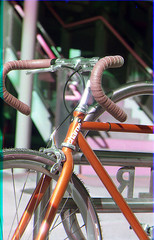Hi, If you want to try is then you need some colour separation filters. I’m currently using Kodak Wratten 25 (Red), Kodak Wratten 61 (Green) and Kodak Wratten 98 (Blue). It took me awhile to find the Kodak Wratten 98. I have used a Hoya 80A for the blue. 80A is a very common filter and really cheap. It works okay but I think the results are nicer with the Wratten 98.
The images from Kuala Lumpur, I used my OM4 and let it meter and exposure for me. If I’m doing it manually then I usually give it +3 stops for the red filter, +1 stop for the green and +3 for the blue. You can experiment and see what you like.
Below is a shot of a bike using the following settings
Film: Ilford Pan 100 (Shot at 100 ISO)
Camera: Yashica 635 - Twin-lens reflex camera
Developer: Rodinal/R09 - Rollei
Stop: Ilfostop
Fix: Ilford RAPID FIXER
Kodak Photo-Flo 200
RED Kodak Wratten 25F8/60+3 stops
GREEN Kodak Wratten 61f8/125+1 stops
BLUE Hoya 80Af8/125+1 stops
 Bike - West India Quay DLR station
Bike - West India Quay DLR station by
abdul hye, on Flickr
When I’m using this technique I always shoot in this order; Red, Green and Blue. When you scan them then you’ll need to know which is which. You can automatically align them in photoshop. Then you need to create a new RGB document and copy and paste each image into the individual channel.
Here is a video of a guy making a print from three negatives. There isn’t any narration but you can get the idea of how to do it.
https://youtu.be/psU24Dp5wl0I didn’t spend more than a few pounds on the filters. You can buy some of them from ebay from people that have listed them on buy it now. But if you wait long enough then someone will list it for 0.99p and chances are you will be them only bidder.
I run a film photography meetup group in meetup.com. If you come to a future event then I can let to use the filters I have on the day. The filters are small, 5cm by 5cm, so won’t cover a large lens.